First interactive lecture for Life in Space Programme
Last week around 150 participants joined the first Life in Space Programme interactive online session. The audience, formed by students, professors and researchers, were distributed across four European universities, and were able to follow and participate in two one-hour lectures.
Hosted by University of Paris VI, the first lecture, “One year of Martian exploration and first results of Huygens mission”, was presented by Dr. Francisc Rocard from the French space agency, CNES. The second lecture, presented by Dr. Sylvie Derenne from the Centre National de la Recherche Scientifique (CNRS) was entitled “Organic matter in meteorites”.
Real-time
Participants at the four Universities (University Pierre et Marie Curie Paris VI, France; University of Sassary, Italy; Autonomous University of Madrid, Spain; University of Bonn, Germany) could follow in real-time both the visuals and speech of the lecturers over the Internet. Towards the end of the session, participants were also able to ask questions and hear the answers.
A further four online sessions are scheduled before June 2005. The second session, on 6 April 2005, will be broadcast from Madrid, Spain. Together the five sessions will serve as preparation for the final two-week ‘Life in Space’ Programme at the Arago Laboratory in Banyuls-sur-Mer, France, in September 2005, and will be complemented with other online activities during the year. This is the fourth year in which ESA collaborates in this ERASMUS-supported course.
e-Learning
The Erasmus User Centre at ESTEC, in Noordwijk, the Netherlands, provided the e-Learning tool used to broadcast the lectures. This first session has confirmed the advantages of using an e-Learning tool in this specific context.
Unique features like being able to record the event for on-demand future purpose, the ability to arbitrate the sessions, the good audio/video performances and the intuitive man-machine interface make it a very suitable tool for this form of remote collaborative work.
The use of an online synchronous tool has solved the problem of having four universities in different countries that want to participate in the same set of lectures, with the obvious advantage of increasing the educational scope of such events to people that otherwise could not travel to follow it on the spot.
All five online sessions will be recorded and stored in a 'virtual classroom'. All the material stored can be accessed and used by students.






